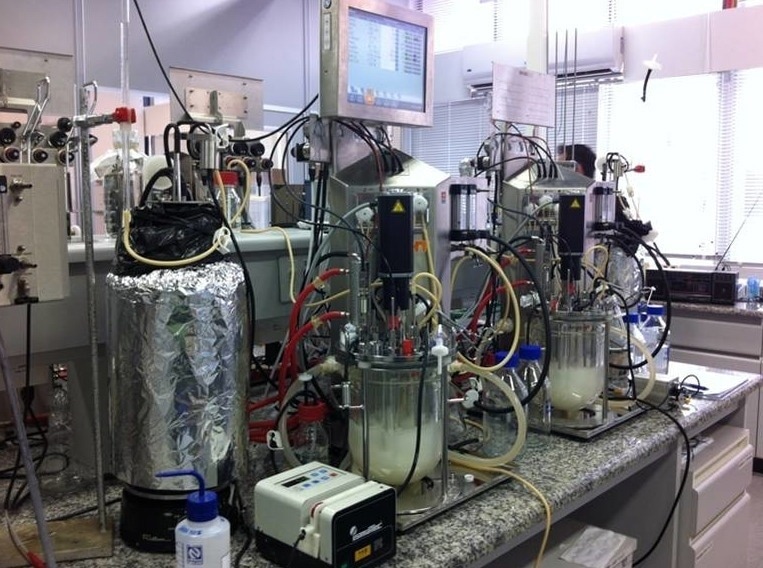A Brazilian study sets the stage for increased efficiency in second-generation (2G) ethanol production by identifying fresh targets for metabolic engineering in a much more robust strain of industrial yeast. The work was published in the journal Scientific Reports.
 Brazilian researchers identified the genes that make the industrial yeast strain Saccharomyces cerevisiae SA-1 resistant to fermentation inhibitors generated during sugarcane bagasse preprocessing. The discovery will be useful as a basis for the metabolic engineering of the microorganism. Image Credit: researchers’ archive.
Brazilian researchers identified the genes that make the industrial yeast strain Saccharomyces cerevisiae SA-1 resistant to fermentation inhibitors generated during sugarcane bagasse preprocessing. The discovery will be useful as a basis for the metabolic engineering of the microorganism. Image Credit: researchers’ archive.
The researchers’ databases are available to the scientific community through the State University of Campinas (UNICAMP), a member of the Dataverse Project, an international collaborative project financed by FAPESP.
First-generation (1G) ethanol is manufactured from carbohydrates (like sucrose), particularly sugarcane, in Brazil. Sugarcane processing produces a huge amount of fibrous leftovers, like bagasse, which can be utilized to generate steam and electricity in power plants.
These leftovers are high in cellulose and hemicellulose (polymeric carbohydrates that preserve the mechanical strength of plant stem cell walls), which can be converted into smaller molecules for fermentation by yeast and other microbes to produce 2G ethanol.
As cellulose and hemicellulose are difficult to hydrolyze, the conversion efficiency is the main hurdle in 2G ethanol production. The tough, stringy lignin, essentially fiber, must be removed first to make the simple sugars found in the cellulose and hemicellulose available to the yeast. This is expensive, uses a lot of energy, and produces chemicals that can impede the fermentation process.
2G ethanol production still requires optimization to increase efficiency. One of the approaches needed entails the identification of yeast strains that resist spoilage by inhibitory molecules derived from the processing of these residues.
Marcelo Mendes Brandão, Study Last Author and Researcher, Center for Molecular Biology and Genetic Engineering, State University of Campinas
Brandão adds, “Some industrial yeast strains are known to have higher levels of tolerance of these compounds. A well-documented example is Saccharomyces cerevisiae SA-1, a Brazilian industrial strain for fuel ethanol that has shown high resistance to inhibitors produced by the pretreatment of cellulosic complexes. This strain was the focus of our study.”
The analysis was conducted in accordance with a Thematic Project funded by FAPESP. Telma Franco, a professor at UNICAMP’s School of Chemical Engineering, was the lead investigator.
FAPESP additionally provided financing to the study group through four more projects (18/17172-2, 11/00417-3, 18/01759-4, and 19/13946-6).
Methods
The investigations were performed by first and second authors Felipe Eduardo Ciamponi and Dielle Pierotti Procópio, both of whom were Ph.D. candidates at the time, in collaboration with Thiago Olitta Basso’s laboratory at the University of São Paulo’s Engineering School (POLI-USP) and Brandão’s lab at CBMEG-UNICAMP.
“To put this study in the context of research on 2G ethanol, we knew certain strains of S. cerevisiae were resistant to these inhibitors, but the molecular mechanism they use to achieve this resistance is complex, involving multiple processes and regulatory pathways,” Basso said.
The research focuses on p-Coumaric acid (pCA), one of the primary inhibitors found in sugarcane bagasse after processing.
Basso notes, “The data available in the literature shows that pCA inhibits biomass yield and lowers the performance of this yeast strain in 2G ethanol production.”
The researchers decided to use a multiomics-based approach combined with bioinformatics to integrate analysis of the transcriptome—the full range of messenger RNA (mRNA) molecules expressed by the organism—with quantitative physiological data to comprehend how the yeast responded to the culture medium. Their goal was to characterize the yeast’s reaction to this important inhibitor at the molecular and physiological levels.
The biological experiments were conducted by Procópio and Ciamponi at POLI-USP’s BioProcessing Laboratory (BELA) with continuous culturing in chemostats, a type of bioreactor in which the physiological and chemical conditions are closely regulated, allowing them to isolate transcriptomic alterations caused by the presence of pCA without interference from other variables influenced by environmental conditions.
The physiological parameters were determined by collecting samples of steady-state S. cerevisiae SA-1 cultured in anaerobic chemostats with and without pCA. A portion of the material was sent to Taiwan for RNA sequencing. The results were examined at CBMEG-UNICAMP’s Integrative Systems Biology Laboratory.
The observations revealed that the yeast strain’s biological mechanisms for surviving under the impact of this inhibitor are even more sophisticated than previously imagined.
The quantitative physiological results revealed that when subjected to pCA stress under anaerobic circumstances, the yeast tended to enhance sugar and ethanol output (relevant to the industrial process).
Brazil has made significant strides in research to improve biomass yields in the manufacturing of bioproducts - consumer goods that can be built, assembled, or produced by converting part of an organism, such as plant tissue and fiber, or by capturing their metabolites.
An example is production of fuel ethanol, a commodity with significant impact on the Brazilian economy.
Marcelo Mendes Brandão, Study Last Author and Researcher, Center for Molecular Biology and Genetic Engineering, State University of Campinas
Journal Reference:
Ciamponi, F. E., et al. (2022). Multi-omics network model reveals key genes associated with p-coumaric acid stress response in an industrial yeast strain. Scientific Reports. doi.org/10.1038/s41598-022-26843-2.